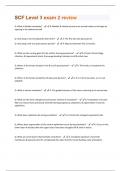Exam (elaborations)
SCF Level 3 exam 2 review Questions and Answers 100% Verified
- Course
- Institution
Q: What is bladder exstrophy? - A: Bladder & related structure are turned inside out through an opening in the abdominal wall. Q: How long is mom bradycardic after birth? - A: The first two wks post-partum Q: How long is the true post-partum period? - A: May last between 9 & 12 months. Q: What ...
[Show more]



